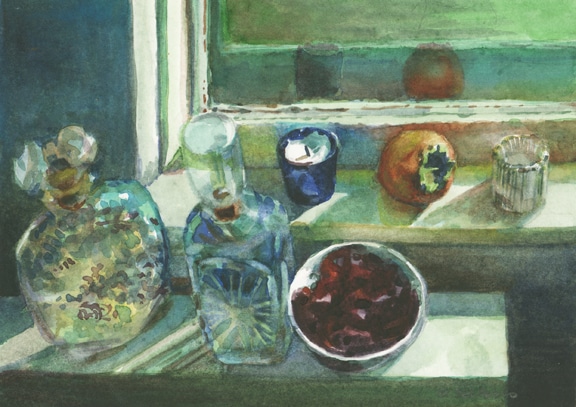
Painting on a Plane
This petite watercolor study was painted while in flight over the ocean, using a reference photo of the sill in my room while I was in college at UMASS a few decades ago. The same couple of photos from this wintery, persimmon and whiskey decanter sunny afternoon have inspired prints and paintings before (here and here). There’s something nostalgic and life-surveying to paint from photos snapped a long time ago. Have you ever used your own family photos, or your grandparents’ vintage photos as references for art-making?
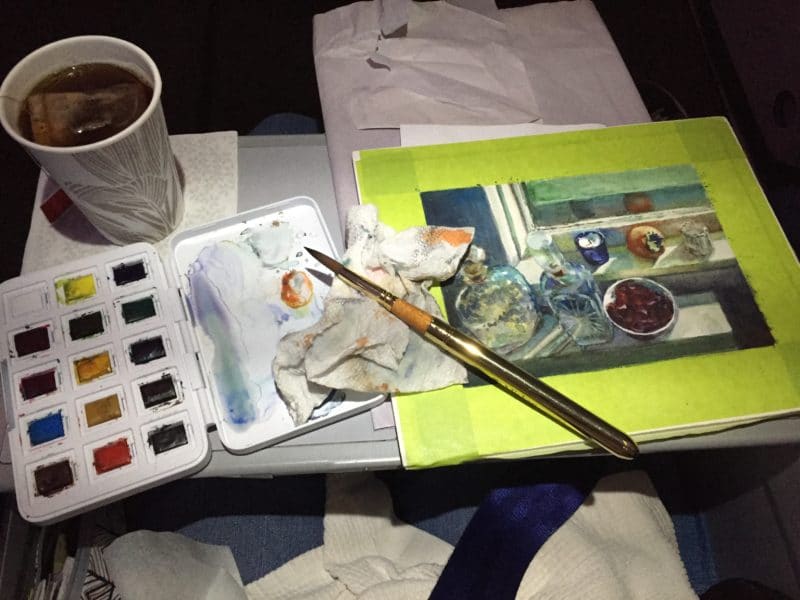
Comparing Watercolor Travel Palettes
I tested the Van Gogh Pocket Box watercolor set while traveling, so I’m sharing my results here in case it’s useful to you. Compared to the Winsor & Newton Cotman travel watercolor set, the Van Gogh box is slightly larger (and as such, it has 15 wells compared to W&N’s 12 wells of pigments). The case has a round #6 travel brush inside, and a separate, nested tray insert you can pull out to expand your mixing area. I’m using the inside cover of the box to hold a pool of water and a mixing space in the photo above, because my airplane surface area is so tiny. (I’m also using a round #12 Pro Arte Midas Touch travel brush, similar to this one, and a sheet of lightweight 8×10 foam core as a support for my paper, held in place with masking tape #becauseIwasinahurry.)
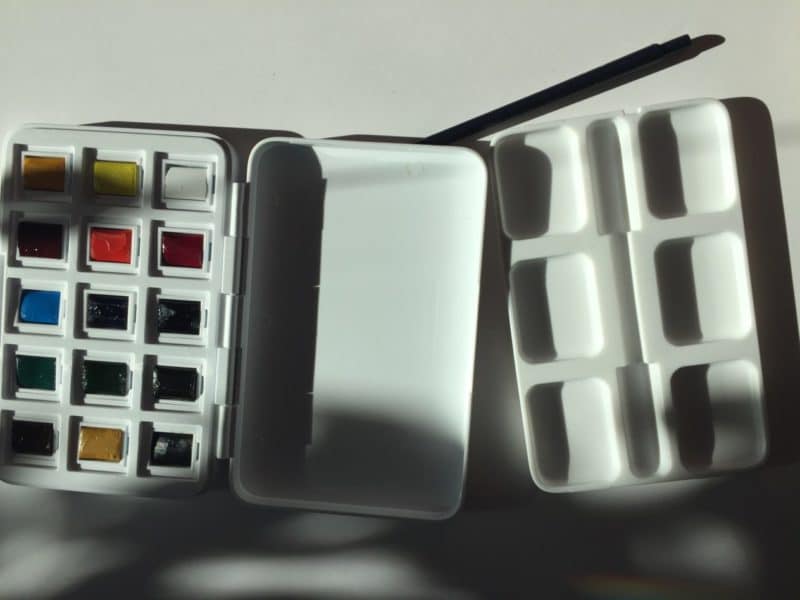
I removed the #6 brush and the extra mixing tray before traveling, since I’m accustomed to using a small palette; airplane tray-tables can be a best-use-of-space challenge. By removing the tray, the pans of color fell out of their little cubbies and rolled around the interior of the case like dominoes, but I just slid them back into a spot each time I used it. This could be annoying to someone who likes their colors in a specific arrangement, so I’d suggest leaving the extra tray in place if that’s how you roll. If you don’t like the colors that come with the palette, you can slide these half pans out and replace them with others, or buy empty half pans and fill with your own pigment choices from tube watercolors. (Leave enough time for them to dry before traveling though.) Overall, I like the Van Gogh Pocket Box just as well as the Winsor & Newton travel palette. The pigments wet easily, responded to mixing very well, and lifted off the paper for lightened passages effectively.
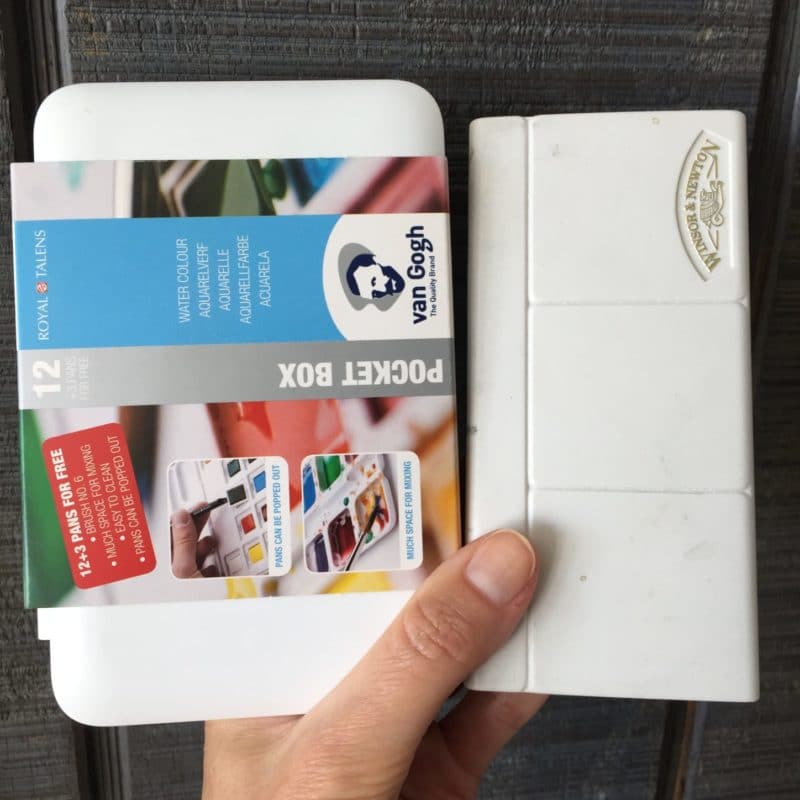
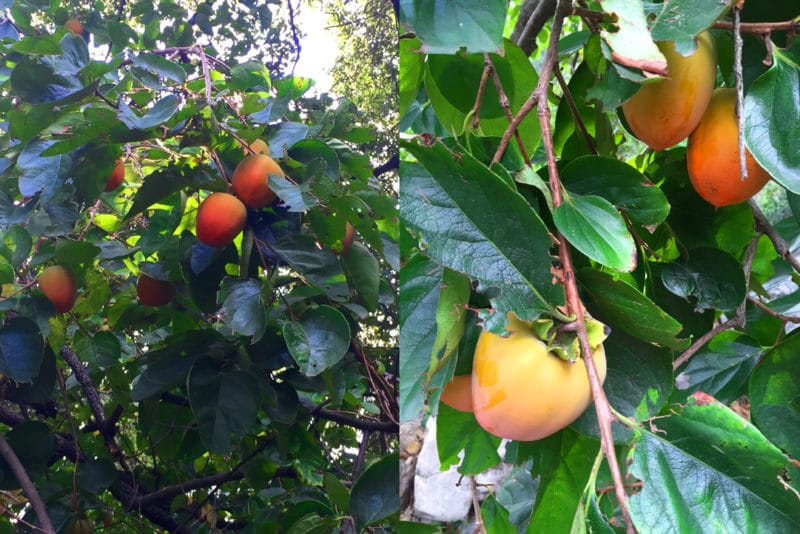
Using Creativity to Climb out of Grief
After the fires and mudslides in my community, I’m relieved to see people starting the slow climb out of grief and loss. For the folks who lost everything, I can barely comprehend where one would start to rebuild a life. My own experience of successfully moving through bereavement is rooted in creativity. I hope that people who don’t consider themselves creative will take the leap to give making (anything) a try. The links below are encouraging essays on the life-affirming salve of creating something new to contradict what has been taken away.
-
- A registered nurse writes about the power of making things with your hands as a comfort for grief and loss.
-
- A Harvard University lecturer and author talks about the surprising connections between grief and creativity.
-
- Author of The Creative’s Curse, Todd Brison outlines a myriad of options for using creativity to cope.
-
- Painter Emily Jeffords (<–see her web site here) describes living a creative life as a vision of standing in a Mediterranean courtyard with the four walls representing inspiration, time, physical needs and family, and cultivating intensional focus on each of them to be happy.
I hope you are making things – in the studio, in the kitchen, in the garden, at a keyboard, or on the couch. No expectation of the outcome, for that will surely cramp the process. Just make something. #fortheloveoftheprocess
🙂 Happy Art-Making to all of you… Thanks for so many kind emails and comments after the Thomas Fire and the Mudslides. We’re all dusting off, standing straight, and getting back to life. I so appreciate every single note; I’ve shared them with my friends here in Ventura.?
I’ll see you in the next post –
Belinda
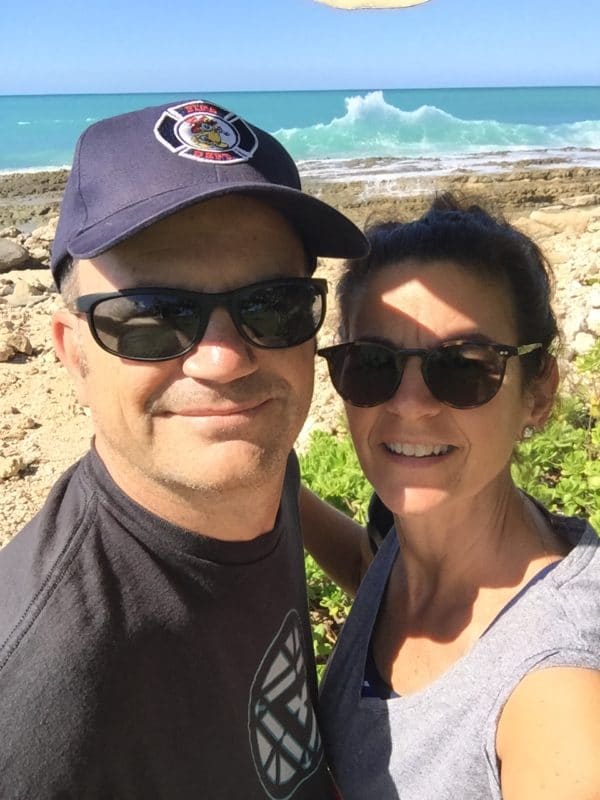
Art Quote
Maxfield Parrish never lacked commissions, critical acclaim, prizes, the resultant fame or other rewards for his artistic endeavors. He seemed to search for a means to balance beauty in every detail, every brush stroke; his graphic designs combined with proportion, subtlety and grace. His vision came early in life and it flourished to the end. Consequently, Parrish works are timeless. He led an extraordinary life and designed its style as neatly as he laid out masonite panels on which to paint.
Then, abruptly, in 1931, Parrish changed focus. Halting all that had made him successful and famous, he began anew, as a landscape artist. His father, Stephen, had followed exactly the same pattern. After years of critical acclaim as an etcher, Stephen Parrish suddenly became an easel painter, painting landscapes until he died in his 90’s.
Maxfield Parrish followed his father’s pattern to the letter. Famous for illustrating everything from toys, games, magazines and book illustrations to advertisements and art prints, he painted only landscape scenes after 1931. Maxfield Parrish died in 1966 at the age of 95, at his beloved New Hampshire home, The Oaks.~from Maxfield Parrish – a Retrospective, by Laurene S. Cutler


Hi Belinda, enjoyed your article about painting on a plane. You make it all seem so effortless. I’m in awe of your ability to complete a whole painting how ever small. I’m thinking you must be sitting in a window seat, yes? The questions I have for you are how do you deal with the plane vibration and items sliding around on the tray. I manage to do a few sketches before take off and while taxiing by holding the sketchbook in hand, braced against my chest. Also tried using brush pens and that didn’t work well because I couldn’t hold a line. The plane vibration creates a shaky effect. To be clear, I’m not talking about turbulence; just normal flying (and people fidgeting, not to mention the seat in front of you sliding back). Have you experienced/had to deal with these issues? ??♀️
Hi Kathryn, Thanks for your description of the challenges of painting or drawing on a plane. It’s certainly not as easy as making art in a calm studio, but if you can find your “groove” and get a little lost in the process, the time zips by and you’re landing at your destination! I do indeed know what you mean about things sliding around and plane vibration. When it’s bad, and the plane moved too much for me to control the brush, I pounded frustration with a club of determination, and switched to loose pencil sketches of flowers or items less dependant on accuracy. On the last few flights, I was in the middle seat, so I did get jostled by elbows & such. But that’s okay – it’s the nature of plane travel. Perhaps try these things: In your sketch kit, keep two small 4″x4″ squares of non skid drawer liner for stabilizing your pad and your palette on the slippery tray. Instead of taking paints, try a canvas roll pouch of colored pencils.(You can see it draped over my lap in this post. This is the one I have.) Bring reference images that are simple, with broad blocks of color and shape, so you can practice loose sketch and block-in samples for later work in the studio. If the plane ride is smooth, you can add details, but at least you have an alternative should the vibrations & jiggling interfere too much. I also cant say enough about headphones to help center your attention to the art: music or an audiobook will block out the people around you, and plane noise and the wandering-mind that most artists wrestle with. I hope you find a way to make this work, because it really does add a nice twist to air travel. Good luck!
I mean a painting of my niece. I could not paint for almost 2 months, but got a commission before Christmas that got me painting again. Outwardly I felt fine, but just realized the level of my grief when I started painting again — I realized that I’d stopped in my tracks. I was in shock. I hold your hand too. Your words move me. Thank you for being an inspiration in every way.
Thank you Belinda. I’m sorry you’ve gone through such a hard time, and sorry for those around you who lost everything. Beautiful painting. Hugs from Toronto. I have not done a painting since she died suddenly in October, but am glad I did paint my beautiful niece when she was alive.
Hello my talented friend, Have you not painted due to time constraints, or is your creative engine taking a bereavement break? I’m sorry for all that your family is going through. She was so young. And yes, it’s *so good* that you painted her portrait earlier… I’m holding your hand.
Thank you Belinda for another interesting and informative blog post. I also believe that being creative during difficult times can help uplift the spirit. I love your plane painting along with many of your creations. (You must be a very popular passenger)
Hi Linda, Thanks for visiting, and I clink my cup of tea to yours in agreement on the art-heals-grief sentiment. Thanks also for the compliments on my plane painting. If you haven’t tried it, I highly recommend giving it a whirl… no one notices, unless you’re in an aisle seat, and wearing headphones to listen to a book, podcasts or music works as a gentle but visible Please Do Not Disturb sign. 🙂 You get lost in the making, and time zips on by.
Speaking of Van Gogh, there’s an interesting article in Vanity Fair this month (?) about Van Gogh’s death. They usually say he committed suicide but the article points out that he was shot in the stomach and drug himself for a mile. One doesn’t usually commit suicide with a stomach shot if you do and you’re really hurting you’d give yourself another one in the head. No gun was found and the doctors who attended him couldn’t make sense of the wounds etc. The article posits that he was murdered. Sorry about the digression off the subject.
Hi TC, There’s a great book called ‘Van Gogh: The Life’ by Steven Naifeh and Gregory White Smith. Take a look at the description on Amazon: http://amzn.to/2GibXvq They explore the possibility that Vincent was accidentally shot by local teenaged boys he knew, and he hid the fact to protect them. But the rumor that it happened stayed with the locals for a whole generation. Here is the teaser to a 60 minutes segment I watched when the book came out: https://youtu.be/DowWa2VZaU0 If you can find the segment and watch the whole thing online, it’s utterly fascinating. And sad.
How timely. I just finished a portrait of my mother-in-law who passed last week. Painting it was helpful emotionally and it is from a photo of her with her first grandchild, my son who is 42 years old….so it definitely is from an old photo. I don’t know how brilliant it is, but it was meaningful for me paint it.
Oh Christine, I’m so sorry for your loss. And you are good to focus on how meaningful it was to paint the image, rather than the outcome. We should paint and make things for the process, not the results, more often. Especially when the normally enjoyable act of laying pigments down is also an opportunity to reflect on and remember the subject of the work. I hope the coming weeks and months are filled with family time, and art making for you.